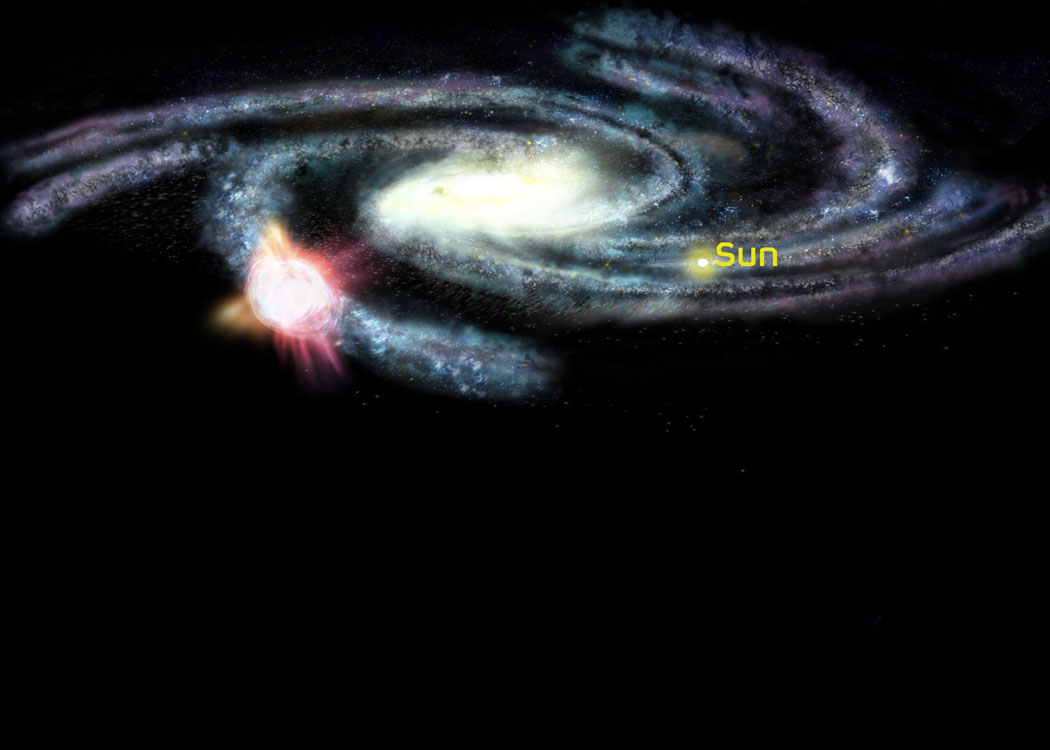THIS ABYSM CITY SKY
SPACE & ASTRONOMY & SKYTHIS ABYSM CITY SKY
SPACE & ASTRONOMY & SKYبرخوردی با راه شیری
Massive Gas Cloud Speeding Toward Collision With Milky Way
Massive Gas Cloud Speeding Toward Collision With Milky Way
A giant cloud of hydrogen gas is speeding toward a collision with our Milky Way Galaxy, and when it hits -- in less than 40 million years -- it may set off a spectacular burst of stellar fireworks.
"The leading edge of this cloud is already interacting with gas from our
Galaxy,"
said Felix J. Lockman, of the National Radio Astronomy Observatory (NRAO), leader of a team of astronomers who used the National Science Foundation's Robert C. Byrd Green Bank Telescope (GBT) to study the object. The scientists presented their findings to the American Astronomical Society's meeting in Austin, Texas.
The cloud, called Smith's Cloud, after the astronomer who discovered it in 1963, contains enough hydrogen to make a million stars like the Sun. Eleven thousand light-years long and 2,500 light-years wide, it is only 8,000 light-years from our Galaxy's disk. It is careening toward our Galaxy at more than 150 miles per second, aimed to strike the Milky Way's disk at an angle of about 45 degrees.
"This is most likely a gas cloud left over from the formation of the Milky Way or gas stripped from a neighbor galaxy. When it hits, it could set off a tremendous burst of star formation. Many of those stars will be very massive, rushing through their lives quickly and exploding as supernovae. Over a few million years, it'll look like a celestial New Year's celebration, with huge firecrackers going off in that region of the Galaxy," Lockman said.
When Smith's Cloud was first discovered, and for decades after, the available images did not have enough detail to show whether the cloud was part of the Milky Way, something being blown out of the Milky Way, or something falling in.
Lockman and his colleagues used the GBT to make an extremely detailed study of hydrogen in Smith's Cloud. Their observations included nearly 40,000 individual pointings of the giant telescope to cover the cloud with unprecedented sensitivity and resolution. Smith's Cloud is about 15 degrees long in the sky, 30 times the width of the full moon.
"If you could see this cloud with your eyes, it would be a very impressive sight in the night sky," Lockman said. "From tip to tail it would cover almost as much sky as the Orion constellation. But as far as we know it is made entirely of gas -- no one has found a single star in it."
The detailed GBT study dramatically changed the astronomers' understanding of the cloud. Its velocity shows that it is falling into the Milky Way, not leaving it, and the new data show that it is plowing up Milky Way gas before it as it falls.
"Its shape, somewhat similar to that of a comet, indicates that it's already hitting gas in our Galaxy's outskirts," Lockman said. "It is also feeling a tidal force from the gravity of the Milky Way and may be in the process of being torn apart. Our Galaxy will get a rain of gas from this cloud, then in about 20 to 40 million years, the cloud's core will smash into the Milky Way's plane," Lockman explained.


ترجمه
برخوردی با راه شیری در راه است
این توده که در سال ۱۹۶۳ کشف شده است با پهنای ۲۵۰۰ سال نوری و طول ۱۱ هزار سال نوری، توجه گروهی از اخترشناسان را به خود جلب کرد تا دانشمندان با تلسکوپ رادیویی «گرین بنک»(Green Bank)، به رصد آن بپردازند.
این توده پس از برخوردی با زاویه حدود ۴۵ درجه به یکی از بازوهای کهکشان، با تغذیه ستارههای راه شیری و برهم زدن شکل خوشههای ستارهای، مقدمه ظهور ابرنواخترهای پی درپی پس از چند میلیون سال خواهد بود، که بی شباهت به آتش بازی کریسمس نیست!(محل برخورد و چگونگی آن را در شکل مقابل ببینید)
این دانشمندان با نقطه گذاری بیش از ۴۰۰۰۰ منطقه از این سحابی به منظور تعیین دقیق شکل و موقعیت سحابی، اندازه ظاهری این توده را در آسمان زمین در حدود ۱۵ درجه برآورد کردند یعنی ۳۰ برابر قطر ماه در آسمان! اما به خاطر این که در سحابی ستارهای وجود ندارد، به صورت مرئی دیده نمیشود.
دانشمندان در ابتدا قادر به تشخیص این که این توده از کهکشان خارج میشود، یا از آن دور میشود نبودند، ولی پس از مشاهده سرعت زیاد توده و رصد آشفتگی در نواحی نزدیک به توده متوجه نزدیک شدن سحابی به کهکشان شدند. در این برخورد منظومه شمسی با زاویهای در حدود ۹۰ درجه، از محل برخورد دور خواهد بود.
همچنین اثرات ناشی از نیروهای کشندی راه شیری در این سحابی مشاهده شده است که شباهت زیادی به اثر گرانش خورشید به دنبالهدارها در منظومه شمسی دارد و ممکن است موجب گسیختگی و از هم پاشیدن قسمتهای کم چگال سحابی قبل از برخورد بخش چگال توده شود.
پس از برخورد توده به راه شیری، گاز هیدروژن
همچون بارانی بر کهکشان فرو خواهد ریخت که در این مرحله احتمال تشکیل سریع ستارههای پرجرم و بزرگ به خاطر شوک برخورد و تزریق گاز هیدروژن وجود دارد.
گروهی از دانشمدان علت پیدایش حلقهای از ستاره های درخشان به نام کمربند «گلد»(Gold) در نزدیکی خورشید را تصادمی مشابه با راه شیری در گذشته میدانند.































